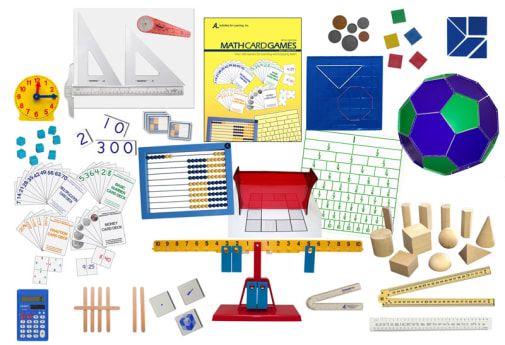This is the manipulatives set that is required for the RightStart 2nd edition mathematics series. The set includes an AL abacus, Math Card Games book (without CD), place value cards, AL abacus tiles, folding meter stick, geoboards, colored 1" tiles, Casio calculator, tangrams, base ten picture cards, tally sticks, geared clock, six card decks, two fraction charts, drawing set, 4-in-1 Ruler, Goniometer, coins, geometry reflector, centimeter cubes, math balance, RightStart geometry panels, geometric solids, and dry erase pen.
RightStart Mathematics Set for 2nd Edition
Product Overview
Description
Included in the RS2 Math Set are:
• AL Abacus Standard
• Math Card Games book
• Place Value Cards
• Base 10 Picture Cards
• Abacus Tiles
• Cards for Math Games
• Fraction Charts
• Drawing Board Set
• Geoboards
• Geometric Solids
• Plastic Coins
• Geometry Panels
• Colored Tiles
• Geometry Reflector
• Casio Calculator 450
• Geared Clock
• Math Balance
• Tangrams
• Centimeter Cubes
• 4-in-1 Ruler
• Folding Meter Stick
• Goniometer
• Tally Sticks
Manuals and worksheets need to be purchased separately or can be purchased as a Book Bundle.
RightStart Math uses a hands-on approach to help children understand, apply, and enjoy math. This is a quality math program, with two editions available. The 2nd edition employs the most recent research and manipulatives are sold as a set.
Based on studies comparing the differences between Japanese and US first grades, RightStart Math incorporates certain aspects from Asian programs such as non-counting strategies and alternative number naming. It teaches students to see quantities in groups of fives and tens. This program also uses a unique number naming system. Students will learn to count the “math-way” (ten-one, ten-two) before learning less intuitive words such as eleven or twelve.
The Cotter Abacus is the primary learning tool and helps children visualize numbers in groups of 5 and 10. Lessons are 30 to 40 minutes, objectives and materials are listed, the page is divided into two columns with activities listed on the left with Warm-Up and instructions for the lesson and new concept, and background and teacher explanations on the right. Worksheets are an opportunity for children to practice the lesson.
Each level of the 2nd edition uses most of the same manipulatives used in the previous edition; however, the sequence and use may change. As a result, there is now one manipulative set that has everything you need for all levels of the program. If you are just starting out with RightStart, you will need the Manipulative Set and the Book Bundle of the level you are starting with. Each Book Bundle contains a spiral-bound lesson book, spiral bound worksheets, and appendix pages for that level. When you get to Level G, you will need several additional manipulatives which are available in a Geometry Set as an add-on or a new user Geometry Set.
EACH BOOK BUNDLE
A and B Bundles include lesson book, worksheets, Yellow is the Sun book, and appendix pages. Level C includes lesson book and worksheets. D - H bundles include lesson book, worksheets, and appendix pages. Levels B-F include review lessons for children who are new to the RightStart program.
LEVELS G & H (GRADES 6-7)
Transitioning to independent lessons, Geometry starts with Level G and continues with Geometry integrated with arithmetic, algebra, and even some trigonometry (Level H), to prepare students for upper-level math, specifically algebra. Encouraging the good study habits of reading and then re-reading through the lessons, the student afterwards completes worksheets correlated to each lesson – usually 1 or 2 per lesson. Students grade their own work using the solutions manual; in consultation with the “facilitator” (a.k.a. parent or teacher). Manipulatives are integral for both courses.
Book Bundles include the Lesson Book, the Worksheets/Binder (with grade recording sheets and games log), and the Solutions Manual. The Lesson Book provides 125 easy-to-use daily lessons, Reviews/ Games after every ten lessons, and three Assessments. Also available are consumable Worksheets for additional students. Requires purchase of manipulatives, either the Geometry New User Set is for families new to RightStart Math, who are starting at Level G or H. The Geometry Add-On Set is for those who have used RightStart and own the 2nd Edition Manipulative Set.
| Product Format: | Math Manipulative |
|---|---|
| Grades: | K-7 |
| Brand: | Activities for Learning |
| Length in Inches: | 28.5 |
| Width in Inches: | 17.5 |
| Height in Inches: | 6 |
| Weight in Pounds: | 14.25 |

